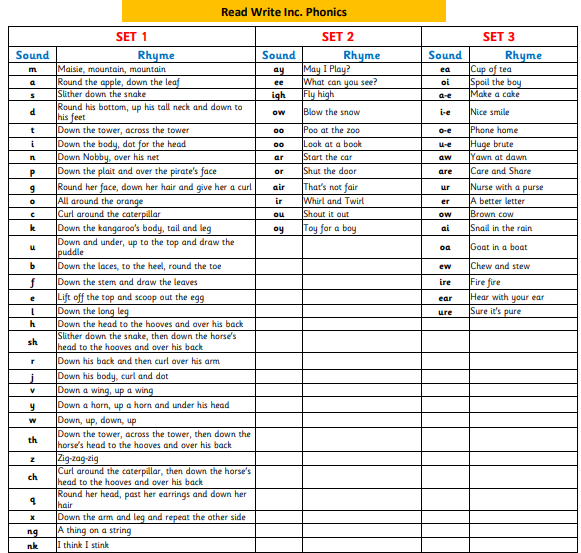Phonics
Teach a child to read, and keep that child reading, and you will change everything.
What is phonics?
Phonics is a way of teaching children how to read and write. It helps children hear, identify and use different sounds that distinguish one word from another in the English language.
Written language can be compared to a code, so knowing the sounds of individual letters and how those letters sound when they’re combined will help children decode words as they read.
Understanding phonics will also help children know which letters to use when they are writing words.
Phonics involves matching the sounds of spoken English with individual letters or groups of letters. For example, the sound k can be spelled as c, k, ck or ch.
Teaching children to blend the sounds of letters together helps them decode unfamiliar or unknown words by sounding them out. For example, when a child is taught the sounds for the letters t, p, a and s, they can start to build up the words: “tap”, “taps”, “pat”, “pats” and “sat”.
Curriculum Vision for Phonics:
The development of pupils’ phonics is a key skill that impacts on their progress as a reader and a writer. It is through their knowledge of phonics that children can read and write unfamiliar words by saying the sounds which match the letters in the words and then blending the sounds together. At St Joseph’s, we strive to ensure that all children become successful, fluent readers by the end of Key Stage One. In order to do this we provide every child with high quality phonics as this plays a key role in children developing word decoding skills.
Curriculum Intent for Phonics:
In EYFS and KS1, a systematic and rigorous approach to phonics will be applied through the delivery of the Read, Write Inc. (RWI) programme.
Throughout the programme, pupils learn the 150+ graphemes that represent the 44 speech sounds. They rapidly learn sounds and the letter or groups of letters they need to represent them, in three sets of Speed Sound Lessons. Simple and enjoyable mnemonics help all pupils to grasp the letter-sound correspondences quickly, especially those who are at risk of making slower progress or those who are new to learning English. This knowledge os taught and consolidated every day. High frequency words that are not phonically regular are taught as ‘tricky’ words, which are known as Red Words in RWI, are practised frequently.
Lively phonic books are closely matched to pupils’ increasing knowledge of phonics and Red Words so that, early on, they experience plenty of success. Repeated readings of the texts support their increasingly fluent decoding.
The 5 Key principles that underpin the teaching in all Read, Write Inc. sessions:
- Purpose – know the purpose of every activity and share it with the pupils, so they know the one thing they should be thinking about.
- Participation – ensure every pupil participates throughout the lesson. Partnership work is fundamental to learning.
- Praise – ensure pupils are praised for effort and learning, not ability.
- Pace – teach at an effective pace and devote every moment to teaching and learning.
- Passion – be passionate about teaching so pupils can be engaged emotionally.
The teaching of sounds in Read, Write Inc.
In Read Write Inc phonics the individual sounds are called ‘speed sounds’ – because we want children to read them effortlessly. Set 1 sounds are the initial letter sounds. They are taught in the following order. m, a, s, d, t, i, n, p, g, o, c, k, u, b, f, e, l, h, sh, r, j, v, y, w, th, z, ch, qu, x, ng, nk
There are 12 Set 2 ‘speed sounds’ that are made up of two or three letters which represent just one sound, e.g. ay as in play, ee as in tree and igh as in high. When children learn their Set 2 sounds they will learn: the letters that represent a speed sound e.g. ay a simple picture prompt linked to the ‘speed sound’ and a short phrase to say e.g. may I play. Every speed sound has a list of green words linked to it, so children can ‘sound out’ and ‘sound blend’ words containing the new speed sound they have just learnt, for example s-p-r-ay = spray. When learning their Set 3 speed sounds they will be taught that there are more ways in which the same sounds are written, e.g. ee as in tree and ea as in tea
As children build up their knowledge of sounds they are able to apply their decoding skills to any unfamiliar word may it be real or nonsense. During lessons each day children will practise their decoding skills by sounding out the letters in ‘Alien words’. Children are unable to rely on existing knowledge of real words, and instead have to use their letter-sound knowledge. This is an important part of the Phonics Screening Test children complete at the end of year 1.
Rhymes are used to support the learning of the letter formation of single letter sounds and the two letter sounds in Set 2 and 3:

When supporting your child with their phonics it is essential that you use pure sounds. Please click on the link below to find a pronunciation support video:
Curriculum Implementation for Phonics
Pupils in Reception and Key Stage One will have a daily phonics session which follows the RWI scheme. Pupils will be in small ability groups so that the phonics teaching is aimed directly at their phonics ability. The aim is that pupils will graduate from RWI by the end of Year 1. When appropriate, pupils will still access the RWI scheme in Year 2 and above to enable them to become fluent readers.
Organisation of the lessons:
All RWI phonics lessons follow a similar routine so when pupils move between groups, pupils know what is expected of them in different parts of the phonics lesson.
Set 1 phonics lessons:
- Say the sound: The adult will model the pronunciation of the sound, discussing if the sound is ‘stretchy’, such as ‘mmmmm’, or ‘bouncy’ such as b,b,b,b. They are introduced to the sounds using picture cards supporting the correct pronunciation of the sounds. Set 1 special friends (more than 1 letter that makes a sound) are introduced in the same way.
- Read the sound: For Set 1 sounds, a simple version of the picture mnemonic is written by the teacher with the teacher pronouncing the sound. The letter is then shown with pupils being shown both versions to practise reading the sound. Set 1 special friends are shown the rhyme to remember the group of letters that make up that sound.
- Review the sounds: The new sound is hidden in the pack of sounds taught so far. Pupils read the sounds and spot the new sound.
- Write the letter: The teacher models the letter saying the rhyme for the letter. Pupils copy the letter.
- Speed write: Once pupils have learnt enough sounds, pupils review some sounds by writing them accurately and with speed.
- Fred talk (oral): The teacher will say a word by using sounds only as Fred can only say words in sounds but not the whole word. The teacher will Fred talk the word and pupils will repeat jumping in with the whole word if they can.
Set 2 and 3 phonics lessons:
- Say the sound: The teacher models the sound and pupils repeat. The teacher will then show the picture and explain it, sharing the rhyme for the pupils to repeat. The teacher will then ‘Fred talk’ some words that include the sound of the day for pupils to blend and say the whole word.
- Read the sound: The teacher recaps the rhyme for the sound using the picture and the pupils repeat. Then the letters are shown that make the sound and pupils practise saying the sound. The teacher flips between the two sides and pupils will say the rhyme or the sound depending on what side is shown.
- Review the sounds: The new sound is hidden in the pack of sounds taught so far. Pupils read the sounds and spot the new sound.
- Word time - Read the words: This section is split into 4:
1. Fred talk: pupils look at the green words (dots and dashes side) and are prompted to say the special friends. Pupils will then use ‘Fred Talk’ to sound out the words e.g. s-p-r-a-y, and then say the word. This is repeated for a number of words.
2. Fred in your head: pupils will do the above for words but in their head. The teacher will prompt them to say the word by pushing the green card forward.
3. Speedy reading: pupils are encouraged to read a set of previously taught green words at speed with accuracy. This may include some red words.
- Nonsense words: pupils will look for the special friends, Fred Talk the word and read the word of some nonsense words.
- Spell with Fred Fingers: Pupils are told a word to spell. Pupils will first repeat the word to spell and then hide their fingers as they count the sounds that make up the word e.g. spray has 4 sounds: s-p-r-ay. Pupils will then hold up their fingers and after repeating the word, they will then pinch their fingers as they say the sounds. Pupils will then write the word. Pupils will tick the spelling of each sound in their own work and fix any corrections. This is repeated for other green words linked to the sound.
- Spell Review: Pupils will practise writing some words with sounds that have previously been taught increasing in speed and accuracy. This may include some red words.
A reading session usually follows the phonics lesson.
Grouping and Assessment:
All pupils are assessed half termly by the Read, Write, Inc leader to ensure a consistent approach. Pupils will then be grouped according to their ability. The pupils are assessed in their Phonic recognition, their ability to decode and their reading fluency.
The pupils work in small groups to follow the structured programme which is tailored to their ability. They are introduced to the vocabulary and parts of the lesson from the beginning and these things will be consistent as the pupils move through the groups. Reception class work through the programme together to begin with and are then split into groups at the end of Autumn 2 ready for Spring 1. Groups are a mix of Reception, Year one and Year two pupils.
Same day interventions
Through careful and ongoing regular assessment and monitoring throughout the lessons, pupils are highlighted for same day interventions where appropriate. These will be led by the adults in the classroom.
Catch-up interventions
Through careful and ongoing regular assessment and monitoring of pupils’ progress, any pupils who may fall behind or in danger of falling behind are identified for catch-up interventions quickly. This will follow the same structure as above and will be a familiar routine to the children. Intervention will focus on targeted pupils identified through recent assessments and will be based around sounds that the pupils do not know whilst also recapping sounds they do know to ensure they can achieve success.
Phonics Screening Check
The phonics screening check is an assessment for the pupils in Year One which takes place during the final summer term. The check assesses the children’s ability to segment and blend words effectively by reading a series of real and non-words (‘alien words’). The check takes place on a one to one basis with the child and their class teacher. Results are submitted and parents are informed whether their child has met the required standard or not. Any child who does not meet the required standard in Year One will have the opportunity to re-take the check the following year during Year Two.
Curriculum Impact for Phonics
Through the successful implementation of a Systematic Synthetic phonics scheme of Read, Write Inc, pupils at St Joseph’s attain above National Average at the Year 1 Phonics Screening Check at 80% (National Average - 78.9%) and our KS1 pupils attaining just above National Average for reading. Our highly trained staff facilitate high quality phonics lessons which are quick paced and enjoyable by the pupils.
For further information for parents on the RWI phonics scheme, please click on the link below:
To access some free RWI ebooks, please click on the link below which will take you to the Oxford Owl website:


